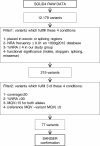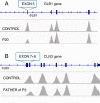Assessment of a targeted resequencing assay as a support tool in the diagnosis of lysosomal storage disorders
- PMID: 24767253
- PMCID: PMC4024120
- DOI: 10.1186/1750-1172-9-59
Assessment of a targeted resequencing assay as a support tool in the diagnosis of lysosomal storage disorders
Abstract
Background: With over 50 different disorders and a combined incidence of up to 1/3000 births, lysosomal storage diseases (LSDs) constitute a major public health problem and place an enormous burden on affected individuals and their families. Many factors make LSD diagnosis difficult, including phenotype and penetrance variability, shared signs and symptoms, and problems inherent to biochemical diagnosis. Developing a powerful diagnostic tool could mitigate the protracted diagnostic process for these families, lead to better outcomes for current and proposed therapies, and provide the basis for more appropriate genetic counseling.
Methods: We have designed a targeted resequencing assay for the simultaneous testing of 57 lysosomal genes, using in-solution capture as the enrichment method and two different sequencing platforms. A total of 84 patients with high to moderate-or low suspicion index for LSD were enrolled in different centers in Spain and Portugal, including 18 positive controls.
Results: We correctly diagnosed 18 positive blinded controls, provided genetic diagnosis to 25 potential LSD patients, and ended with 18 diagnostic odysseys.
Conclusion: We report the assessment of a next-generation-sequencing-based approach as an accessory tool in the diagnosis of LSDs, a group of disorders which have overlapping clinical profiles and genetic heterogeneity. We have also identified and quantified the strengths and limitations of next generation sequencing (NGS) technology applied to diagnosis.
Figures



Similar articles
-
Assessing Lysosomal Disorders in the NGS Era: Identification of Novel Rare Variants.Int J Mol Sci. 2020 Sep 1;21(17):6355. doi: 10.3390/ijms21176355. Int J Mol Sci. 2020. PMID: 32883051 Free PMC article.
-
A Comprehensive, Targeted NGS Approach to Assessing Molecular Diagnosis of Lysosomal Storage Diseases.Genes (Basel). 2021 Oct 30;12(11):1750. doi: 10.3390/genes12111750. Genes (Basel). 2021. PMID: 34828358 Free PMC article.
-
Clinical implementation of gene panel testing for lysosomal storage diseases.Mol Genet Genomic Med. 2019 Feb;7(2):e00527. doi: 10.1002/mgg3.527. Epub 2018 Dec 11. Mol Genet Genomic Med. 2019. PMID: 30548430 Free PMC article.
-
Lysosomal storage disorders: molecular basis and laboratory testing.Hum Genomics. 2011 Mar;5(3):156-69. doi: 10.1186/1479-7364-5-3-156. Hum Genomics. 2011. PMID: 21504867 Free PMC article. Review.
-
Current molecular genetics strategies for the diagnosis of lysosomal storage disorders.Expert Rev Mol Diagn. 2016;16(1):113-23. doi: 10.1586/14737159.2016.1121101. Epub 2015 Dec 9. Expert Rev Mol Diagn. 2016. PMID: 26567866 Review.
Cited by
-
Molecular findings of Colombian patients with type VI mucopolysaccharidosis (Maroteaux-Lamy syndrome).Meta Gene. 2015 Dec 23;7:83-9. doi: 10.1016/j.mgene.2015.12.004. eCollection 2016 Feb. Meta Gene. 2015. PMID: 26909334 Free PMC article.
-
NGS Technologies as a Turning Point in Rare Disease Research , Diagnosis and Treatment.Curr Med Chem. 2018 Jan 30;25(3):404-432. doi: 10.2174/0929867324666170718101946. Curr Med Chem. 2018. PMID: 28721829 Free PMC article. Review.
-
Assessing Lysosomal Disorders in the NGS Era: Identification of Novel Rare Variants.Int J Mol Sci. 2020 Sep 1;21(17):6355. doi: 10.3390/ijms21176355. Int J Mol Sci. 2020. PMID: 32883051 Free PMC article.
-
Clinical and genetic characteristics of type I sialidosis patients in mainland China.Ann Clin Transl Neurol. 2020 Jun;7(6):911-923. doi: 10.1002/acn3.51058. Epub 2020 May 29. Ann Clin Transl Neurol. 2020. PMID: 32472645 Free PMC article.
-
Identifying Children With Poor Cochlear Implantation Outcomes Using Massively Parallel Sequencing.Medicine (Baltimore). 2015 Jul;94(27):e1073. doi: 10.1097/MD.0000000000001073. Medicine (Baltimore). 2015. PMID: 26166082 Free PMC article.
References
-
- Stone DL, Sidransky E. Hydrops fetalis: lysosomal storage disorders in extremis. Adv Pediatr. 1999;46:409. - PubMed
-
- Beaudet A, Scriver C, Sly W, Valle D. In: The Metabolic and Molecular Bases of Inherited Disease. 7. Scriver C, Beaudet A, Sly W, Valle D, editor. New York: McGraw-Hill; 1995. Genetics, biochemistry and molecular basis of variant human phenotypes; pp. 53–118.
Publication types
MeSH terms
LinkOut - more resources
Full Text Sources
Other Literature Sources
Molecular Biology Databases

